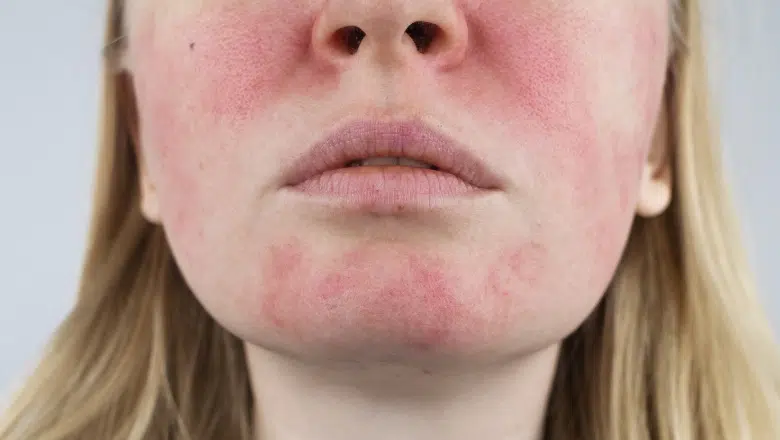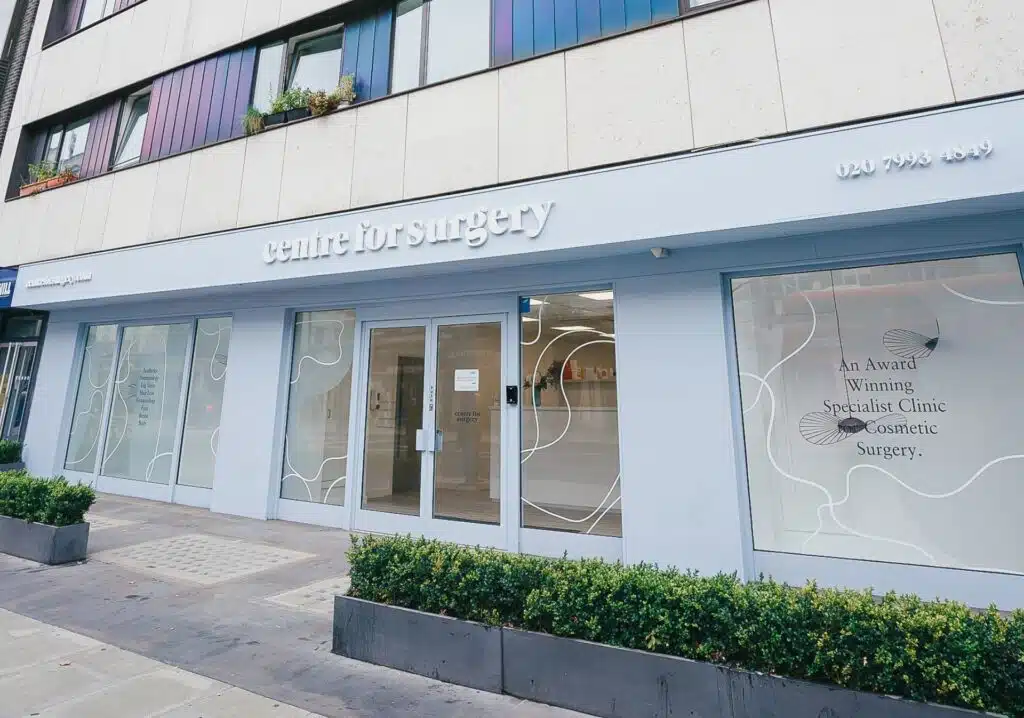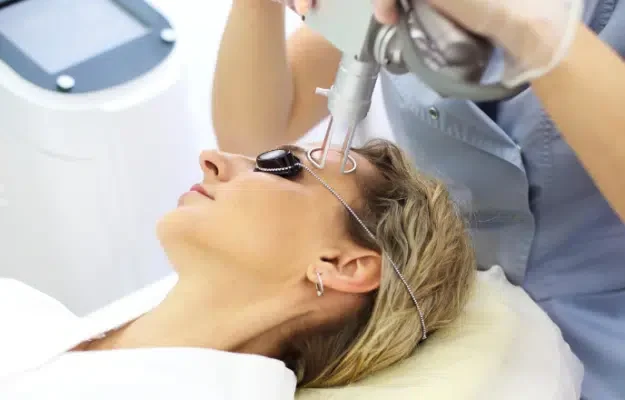Rosacea has several characteristic clinical features, and our specialists will accurately assess you to determine your particular sub-type of rosacea. The following clinical features are most commonly found in most forms of rosacea:
- Persistent facial flushing and redness – Patients with rosacea often have diffuse facial redness with associated flushing. In many cases, patients often report their faces feeling very warm when the flushing starts.
- Inflammatory lesions (red papules and pustules) – small red lesions that are raised along with small pustule lesions. In papulo-pustular forms of rosacea, acne can be mistakenly misdiagnosed as the two conditions look very similar. The key distinction lies in most patients’ stinging and burning sensation with papulopustular rosacea.
- Facial thread veins (telangiectasias) – facial thread veins are often seen on the cheeks and nose. These blood vessels are also known as facial telangiectasia and are often a feature of the inflammation in rosacea.
- Facial warmth, burning, or stinging sensation – patients often experience a warming sensation on the face in the early phase of rosacea, which progresses to burning and stinging sensations when patients experience an exacerbation of rosacea.
- Facial oedema – swelling of the face is a ubiquitous feature of rosacea.
- Disfigurement of the nose – In advanced cases of rosacea, particularly in men, the skin of the nose may begin to thicken and can cause severe cosmetic disfigurement. This is called rhinophyma, and severe cases may even impair breathing.
- Red and watery eyes – Ocular rosacea is a distinct subtype often presenting as red, watery, and irritable. The eyelids can look inflamed, mimicking the appearance of blepharitis. In more advanced cases of ocular rosacea, localised bacterial infections of the eyelids can occur or even visual disturbance in severe cases.
Understanding the Advantages of Laser Therapy for Rosacea Management
Laser treatment for rosacea offers a significant advancement in managing this often distressing skin condition. Rosacea, known for causing redness and visible blood vessels in the face, can impact self-esteem and social interactions. Traditional treatments, while beneficial, don’t always provide comprehensive results. However, laser therapy emerges as a highly effective alternative, delivering notable improvements in skin appearance and health.
One of the primary benefits of laser treatment for rosacea is its ability to reduce facial redness. The laser targets and diminishes the appearance of fine blood vessels that contribute to the redness, leading to a more even skin tone. This treatment is particularly effective for those who haven’t responded well to topical or oral treatments.
Laser therapy also helps in reducing inflammation associated with rosacea. By targeting the inflamed areas, it reduces swelling and skin discomfort, enhancing the overall skin texture. This is crucial for rosacea sufferers, as inflammation can often lead to further skin complications if left untreated.
Another advantage is the precision of laser treatment. It allows for targeted therapy, focusing only on affected areas without damaging surrounding healthy skin. This precision ensures that the skin’s integrity is maintained while effectively treating the condition.
Moreover, laser therapy for rosacea offers long-term benefits. While no treatment can cure rosacea completely, laser therapy can provide prolonged periods of symptom relief. Patients often report a significant reduction in flare-ups and an improved ability to manage their condition with fewer interventions.
The psychological benefits of laser treatment are also noteworthy. Rosacea can cause significant emotional distress, affecting one’s confidence and social interactions. By improving the physical symptoms of rosacea, laser therapy can lead to enhanced self-esteem and quality of life.
Lastly, laser treatment is a relatively quick and convenient procedure. Sessions are typically short, and there is minimal downtime involved, allowing patients to return to their daily routines swiftly.
Fotona Laser treatment for Rosacea
Lasers in the treatment of rosacea can reduce both erythema and telangiectasia. The objective is to reduce the density of the blood vessels in the superficial part of the skin, which leads to a reduction in redness and both flushing symptoms and burning and stinging sensations. Many lasers and light devices have been increasingly used to treat rosacea. The laser can be used for both the two most common subtypes of rosacea – erythematous-telangiectatic (ETR) and papulopustular (PPR) forms. The long-pulsed Nd:YAG laser is an excellent laser treatment used by the Centre for Surgery specialists. With Nd:YAG treatment, the entire face is treated. There is no requirement for topical anaesthesia, although an air-cooling device is used to protect the skin and reduce discomfort during treatment. Treatment is repeated at 3-4 week intervals.
RELATED: Facial Thread Vein Removal
Patients treated with Nd:YAG laser can become asymptomatic. However, it cannot be considered a cure as the underlying disease processes are not fully addressed, and the patient may experience an exacerbation. However, in our experience, it does lead to long periods of disease remission. Because of lower melanin absorption with Nd:YAG lasers, there is less concern for epidermal damage, and they may be more safely used to treat patients with darker skin. Compared to other lasers, the risk for post-inflammatory hyper-pigmentation is very low. Nd:YAG laser is a very successful treatment in rosacea patients, and the effect among ETR patients was more significant than for PPR patients.
RELATED: How Much Does Rosacea Laser Treatment Cost?
Other Rosacea Treatment Options
Currently, there is no single treatment which will eliminate rosacea. Treatment is therefore targeted based on symptoms, severity and the specific type of rosacea. Combination treatment is usually the best treatment strategy.
Topical prescription medications for rosacea
Topical antibiotics are used to reduce facial redness and are known to be effective in reducing the pustular component of rosacea. Recurrent symptoms are uncommon and are generally safe and effective, with a small risk of side effects, including irritation and dermatitis.
Azelaic acid has antioxidant, antimicrobial, and anti-inflammatory properties, which help to reduce redness and skin thickening. It is applied once daily and is safe to use in pregnancy. Side effects are minor, including irritation, dryness, and burning/stinging sensation.
Retinoids can stimulate connective tissue remodelling, which helps to repair any sun-induced damage. They also have anti-inflammatory actions. In combination with other topicals, topical retinoids can reduce redness, papules and/or pustules, although treatment can take months.
Oral Prescription Medications for rosacea treatment
Tetracycline antibiotics have been used for rosacea treatment for over 50 years and are generally safe. Tetracycline antibiotics are used to both treat and prevent rosacea. They exert useful anti-inflammatory effects, which help to reduce redness. Other antibiotics, such as may also be used.
Although topical and oral antibiotic treatments are suitable for inflammatory aspects of rosacea, they are less effective in improving the diffuse redness and prominent facial blood vessels.
Roaccutane is usually the last line of treatment for patients who have shown a lack of response to other commonly used treatments. Roaccutane taken at low doses has improved facial redness, papules and pustules with a lower risk profile. Roaccutane carries recognised adverse side effects, and all patients are placed under the close supervision of a dermatologist. It is very important to use adequate contraception while on Roaccutane as the drug is not safe to use in pregnancy (risk of birth defects).
IPL treatment for rosacea treatment
Rosacea can sometimes be treated with IPL or intense pulsed light to achieve effective symptom control in relapses of the condition. IPL acts on the small superficial blood vessels located beneath the skin. The pulses of light emitted from the IPL handpiece impart thermal energy to the blood vessels, causing them to reduce in size significantly. The appearance of the skin is visibly improved following treatment. Specialists take special precautions during treatment to prevent injury to other parts of the skin. It is expected to experience mild discomfort during treatment, often compared to a light flick of an elastic band against the skin. Sometimes, you may prefer to have a topical anaesthetic applied before treatment. The final results are determined by the number of treatments and the severity of the rosacea grade.
RELATED: How to Prevent Rosacea
Rosacea FAQs
What is Rosacea?
Rosacea is a highly prevalent skin condition and affects many people in the UK. Rosacea is a chronic skin condition which tends to undergo an unpredictable course. Low-grade inflammation is responsible for the facial redness, flushing and the often visible blood vessels or facial thread veins. In untreated cases of rosacea, the patient may develop raised papules and pustules on the face. Rosacea undergoes flare-ups, which can last a few weeks to many months, followed by spontaneous resolution without active treatment. Rosacea can, in many cases, mimic the appearance of active acne.
Rosacea commonly develops after age 30 and tends to affect people with lighter skin types. Although rosacea is seen more commonly in women, the more severe grades of rosacea tend to occur in men. In many cases, rosacea can be hereditary, with the condition running in families. There is no definitive cure for rosacea, but fortunately, many excellent treatments have a proven track record. Our laser skin specialists are specially trained in the treatment of rosacea and achieve excellent outcomes to improve the quality of life of rosacea sufferers.
What Causes Rosacea?
Rosacea remains an incompletely understood condition, and the precise causes are unknown. There are, however, several possible explanations for the appearance of facial redness:
Defects in blood vessels
The facial redness of rosacea may partly be down to an underlying defect in the superficial blood vessels. Blood vessel dysfunction is possibly linked to raised levels of several growth factors, including vascular endothelial growth factor, certain prostaglandins, and pro-inflammatory cytokines. VEGF is responsible for the proliferation of new blood vessels. VEGF also makes the tiny capillaries more leaky, releasing the plasma part of blood into surrounding tissues. This results in a localised inflammatory process, leading to the commonly observed signs of redness. The prostaglandins are responsible for increasing the diameter of the blood vessels, contributing to the redness observed.
Inflammatory processes
In more chronic forms of rosacea, the facial flushing and chronic skin changes are often due to pro-inflammatory cytokines. The dermodex mite parasite has also been found in more chronic forms of rosacea. The follicle sebaceous shafts are where the mites tend to reside. Research has shown raised levels of the dermodex mite in rosacea sufferers. With increased levels of mites, skin irritation then becomes an added problem.
Everyday common precipitating causes of rosacea
The exact causes of rosacea are unknown, although there are known to be several triggers which can make rosacea appear. For any rosacea sufferer, it is essential to steer clear of these triggers for optimal control.
Food with a high spice content, such as Indian food
Heavy alcohol intake
Hot cups of tea or coffee
Hot showers, saunas or steam rooms
What happens at my rosacea consultation at Centre for Surgery?
You will be booked in to see one of our expert laser skin specialists at Centre for Surgery on Baker Street in Marylebone for your rosacea consultation.
The laser specialist will perform a thorough clinical examination of your skin and will discuss several aspects with you:
– Treatment options based on the type of rosacea you have and what kind of results can be expected with the proposed treatment
– What the treatment involves, including how often to apply the medication to the skin if you are prescribed a topical treatment
– Review your medical history, including any medicines you may be taking
– Answer your questions about any aspect of the treatment
Patient journey summary:
– Arrange a consultation at our laser skin clinic at 95-97 Baker Street, Marylebone, for a face-to-face consultation with an expert practitioner
– Commence a course of treatment for rosacea based on your needs and preferences
– Arrange a follow-up appointment if required to be seen by our specialists to review the effectiveness of treatment
RealSelf Top Doctors
RealSelf’s top doctor status is awarded to less than 10% of the RealSelf doctor community. This status is earned by achieving consistently high patient satisfaction (from RealSelf reviews), getting excellent feedback on expert answers to patient questions, and investing significant time in Q&A and other doctor activities. RealSelf’s top doctors are rated among the best specialists in the United Kingdom.












